How to choose a spinning wheel
How do I select a spinning wheel?
A great question, and one that will set you on an oh-so-rewarding adventure! You win by simply asking…
Luckily, spinning wheels these days are built to be good all-around performers. They are also generally made by small companies that are passionate about spinning, quality and service: Ashford, Louet, Schacht, Kromski and Majacraft are great supporters of the spinning community and we offer a complete selection of their products. Plus when you buy a spinning wheel at Halcyon Yarn it ships free within the continental USA!
Except for a few specialty wheels, most all models will help you learn to spin quickly, and make a great variety of mid weight yarns. That said, there are important differences and you can definitely give yourself a head-start with a little planning. Some things to consider at the outset and some questions that may guide you… Do you:
- Have limited space or lots of space?
- Want to be able to take your wheel with you to spinning groups or for travel?
- Find yourself drawn to traditional looks, or prefer a modern take?
- Want to spin mostly mid weight yarns, or know you’ll concentrate on either super bulky or super fine yarn?
As we talk about how to choose a spinning wheel, we’ll consider some of the parts of a wheel. These parts should be functionally similar even between very different looking wheels:
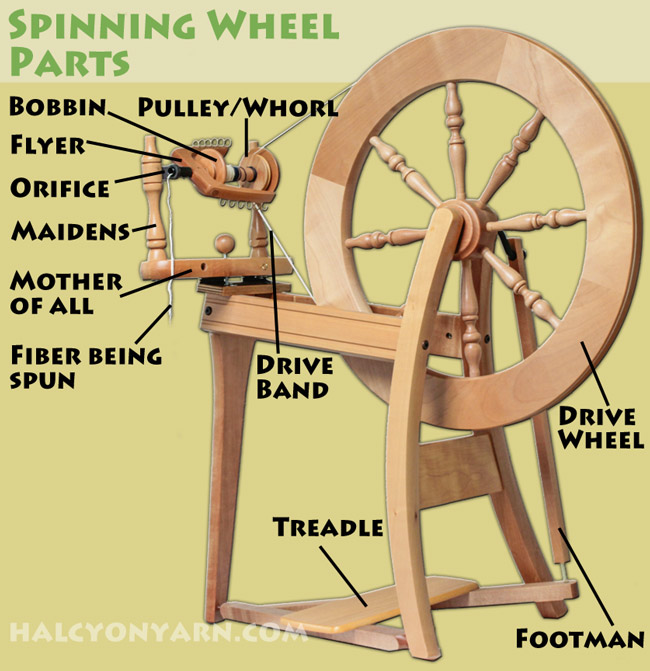
Ok, now we’re ready to make some comparisons. With a little looking, you can get a wheel that will feel just right, look just right, and spin yarn you’ll LOVE! Making a “good choice” for a first spinning wheel will keep you smiling for many years to come!
First decision: Traditional vs. modern spinning wheels
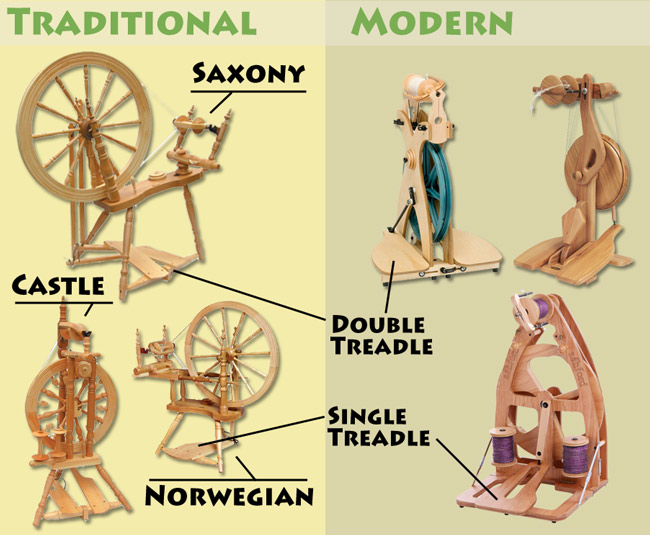
Traditional Spinning wheels:
- Are the ones in storybooks. The Saxony style is what Rumpelstiltskin used.
- Often have ornate construction and may take up more space than modern wheels.
- Not typically able to fold for travel.
- Do still take advantage of modern components; they can be versatile, and spin easily and well.
…
Modern Spinning wheels:
- Are diverse, with many shapes and sizes
- Tend to focus more on function than traditional design per-se (though some are very cute).
- Often are able to fold, are lighter, and have a smaller “footprint”.
- Evolve more quickly to incorporate new ideas, trends and improvements.
The verdict: which style is right for you?
Spinning wheels work similarly, and share similar parts, regardless of whether they are traditional or modern. If you like a traditional look, have a good space for a larger wheel, and don’t anticipate taking your wheel with you – go with traditional. There are a few smaller / lighter traditional wheels that strike a good compromise too.
If your priority is a lightweight wheel that you can fold up and take to your spinning group, is versatile and takes advantage of new trends, you’re most likely to find a good fit with a modern spinning wheel.
If you don’t have a strong preference, keep an open mind, as other factors may help you to narrow your choice.
Next up: treadling. Single treadle vs double treadle
Treadling is spinning the drive wheel by pressing on one or two treadles at the base of the wheel. One treadle or two may seem like a major decision, but it’s usually more a matter of personal preference: once you get the hang of it, both work equally well for most people.
…
Why choose double treadle:
- You like the rhythm of treadling with two feet
- Beginners may find double treadle easier to control
- The work is split between both feet, allowing more opportunity for control and dividing the work
- You can still treadle with one foot if you prefer
…
Why choose single treadle:
- They can have an elegant and more traditional look
- Fewer parts: simplicity of design and maintenance
- You strongly prefer treadling with one leg over the other
- Easier to switch feet, and rest one leg while the other works
- Easier to change your orientation toward the wheel
Double vs Single treadle: the verdict
For beginners, double treadle may edge out single treadle due to more easily controlling speed. However, the difference is not huge, and with a bit more practice learning on a single treadle isn’t a problem. The even motion of double treadle may be better if you have back trouble or other health considerations, and would benefit from an always-balanced treadling motion. Still, for most people these aren’t “deal-breaker” differences.
Single treadle spinning wheels are great for those who like a traditional look and simplicity of design. They’re also good if you like a little more freedom in how you orient yourself toward the wheel.
Many wheels come in both styles, so feel free to select double treadle if it makes sense, but don’t necessarily rule out a single treadle, even if you’re just learning.
Scotch, Irish, double drive, what? Spinning wheel drive options
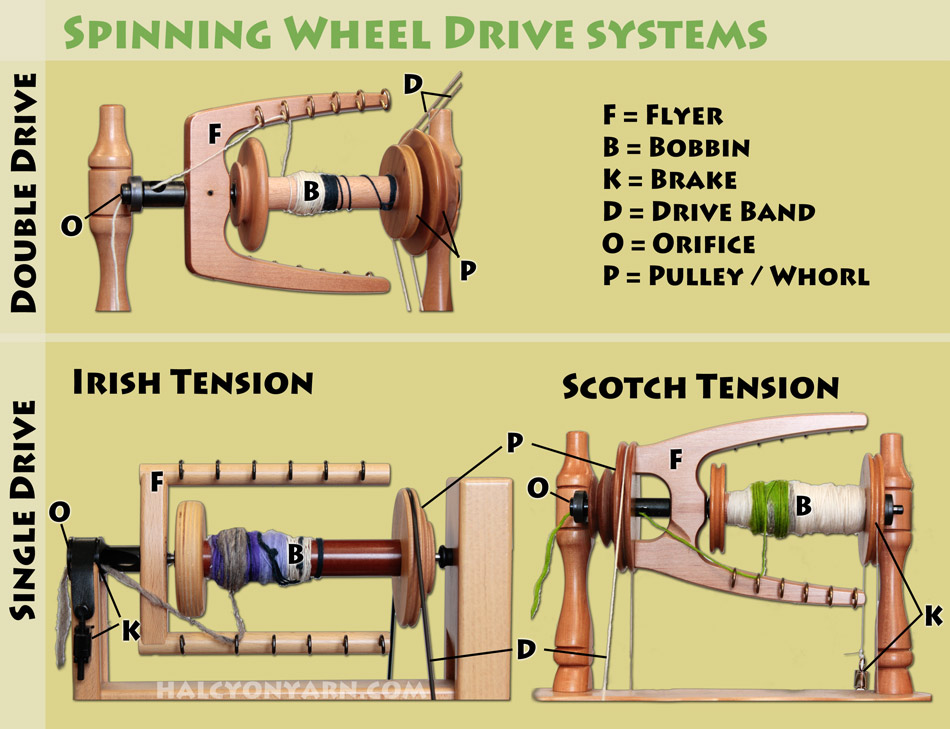
When looking for a spinning wheel, you’ll hear people talking about single drive “Scotch or Irish tension”, and “double drive” wheels. They may even ask a panic-inducing “what’s your preference?” Don’t fret! These are just different ways of controlling how much twist is added to your yarn, and how quickly it is wound on to the bobbin. You can learn to spin on any tension system. To understand the similarities and differences, some basics:
…
What’s the same:
- Fiber leaves your hand and goes trough the orifice to the flyer: the spinning of the flyer adds twist, making yarn
- The bobbin stores the twisted fiber/yarn
- Both the flyer and bobbin spin: if they spin at the same speed, only twist is added, and the fiber is not wound on to the bobbin
- Adding “tension” by pulling back on the fiber being spun slows yarn from being wound on to the bobbin, which adds more twist. Releasing tension causes yarn to wind onto the bobbin.
…
What’s different:
- Scotch tension: the flyer is spun by the drive band; it always spins. Pulling on the fiber causes the bobbin to spin with the flyer to add more twist: otherwise the brake on the bobbin slows it to wind on yarn.
- Irish tension: The bobbin is turned by the drive band: it always spins. Pulling on the fiber causes the flyer to spin to add more twist: otherwise the brake on the flyer slows it to wind on yarn.
- Double drive: the bobbin and flyer are both driven by a drive band: the bobbin spins faster, but can slip to add more twist.
We have a full explanation of spinning wheel drive options in a separate post.
Drive options: the verdict
Irish tension, or single drive bobbin lead spinning wheel: Popular with beginners because they have a strong pull makes it easier to get the “feel” of controlling how much twist to add. The strong pull also means that they are great for bulky yarns. Irish tension spinning wheels tend to treadle the easiest, which some people prefer. They may require more finesse and practice for fine yarns. Super fine or cobweb yarns may be difficult on Irish tension.
Scotch tension, or single drive flyer lead spinning wheel: great all-around performers, these do well with very fine yarns. You can adjust the brake to let the bobbin spin with the flyer even when pulling very lightly, which is why it works well for superfine yarn. You can also adjust the bobbin to pull more strongly for heavier yarns. Scotch tension wheels are versatile and popular.
Double drive spinning wheels: you could almost say they have auto-pilot. Without tension, both the bobbin and flyer are spun. The bobbin spins faster so you’ll wind on yarn while adding twist with the flyer. You can change how much twist is added by using different “pulleys” to let the bobbin spin a little or “a lot” faster (see “ratios” below). You can also cause the bobbin “slip” and therefore to spin with the flyer to add more twist, like with Scotch tension. Adjusting how easily the bobbin slips can be tricky, but it’s easily learned. Double drive wheels are a joy to use for spinning fine and medium yarns.
Many double drive wheels can be converted to single-drive Scotch tension, so if you’re interested in either Scotch tension or double drive, you may want to consider a double drive wheel. All in all, this is a very versatile set-up.
Don’t overlook: Drive Ratios
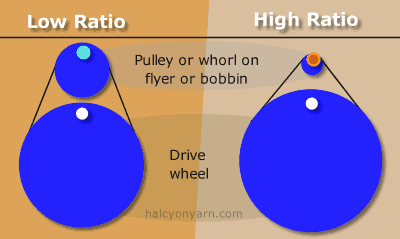
Think of ratios as gears on a bike. Ratios describe how fast your flyer or bobbin spins compared to how fast you treadle your drive wheel. Drive ratios are important for spinning different weight yarns: Low (slow) ratios are for bulky yarns, high (fast) ratios are for finer yarns.
A typical low ratio might be written as 4, 4:1, or “4 to 1”. This simply means that the bobbin or flyer rotate 4 times each time the drive wheel rotates once. An example high ratio might be anywhere from 10:1 to 30:1.
You can change ratios! Simply change the pulley or whorl size. A larger pulley or whorl means slower spin. Just like on a bike how low gear is easier to peddle, on a spinning wheel low ratios are easier to treadle.
Drive ratios: the verdict
Luckily, most wheels are capable of a good range of ratios and work well for commonly spun yarns. If you know you want to spin fine yarns, look for a wheel with higher range ratios. If you anticipate working with bulky yarns, look for a wheel that includes lower ratios.
The extras
Turns out there is more to spinning than just the wheel! Does the wheel come with extra bobbins, whorls, or flyers? What about a Lazy Kate (which is a stand for bobbins, very useful for plying spun fibers into multi-ply yarns)? Does it include a carrying case?
The best spinning wheel for you: final answer?
Most important? Ask questions! We’re happy to answer questions by email or phone (1-800-341-0282) during our business hours. We’ve been helping spinners since 1971, and few things are more rewarding than seeing the excitement of someone getting started with the right equipment. Remember, spinning wheels ship free with standard ground shipping within the continental USA. Call or see items online for complete details.
We hope you enjoy these wheels as much as we do, and we look forward to hearing from you!
The Spinning Wheels
So many good choices! Take a gander, give us a call…
Ashford Spinning Wheels |
|
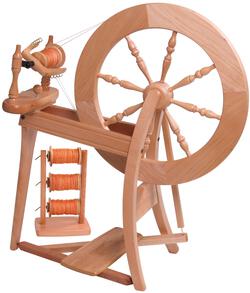 |
Traditional |
| Drive Wheel Diameter | 22” |
| Weight (lbs) | 17.5 lbs |
| ratios | S/D 6.5, 12.5, 17.5 D/D 7.5, 10, 14 |
| bobbins (capacity) and accessories | 4 bobbins (3.-4 oz) Lazy Kate Threading Hook How To Spin Booklet |
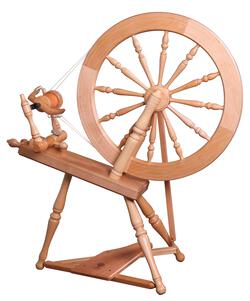 |
Elizabeth II* |
| Drive Wheel Diameter | 24” |
| Weight (lbs) | 20 lbs |
| ratios | D/D 8.5, 11, 15:1 |
| bobbins (capacity) and accessories | 4 bobbins (3.-4 oz) Lazy Kate Threading Hook How To Spin Booklet |
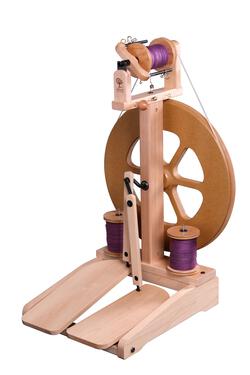 |
Kiwi |
| Drive Wheel Diameter | 17.” |
| Weight (lbs) | 12 lbs |
| ratios | S/D 5.5, 7.25 |
| bobbins (capacity) and accessories | 3 bobbins (3.-4 oz) Lazy Kate, Threading Hook How To Spin Booklet |
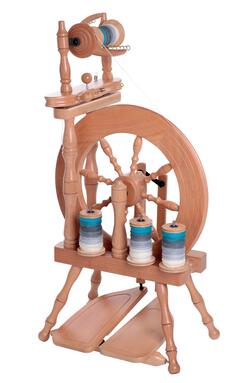 |
Traveller* |
| Drive Wheel Diameter | 18” |
| Weight (lbs) | 15 lbs |
| ratios | S/D 5.5, 10, 14 |
| bobbins (capacity) and accessories | 4 bobbins (3.-4 oz) Lazy Kate Threading Hook How To Spin Booklet |
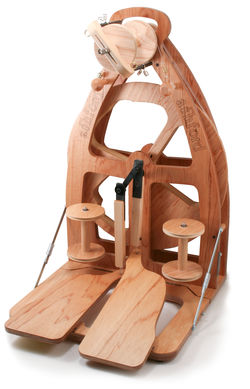 |
Joy* |
| Drive Wheel Diameter | 15.” |
| Weight (lbs) | 11 lbs |
| ratios | 6, 8, 11, 14 |
| bobbins (capacity) and accessories | 3 bobbins (4 – 5 oz) Built in Lazy Kate |
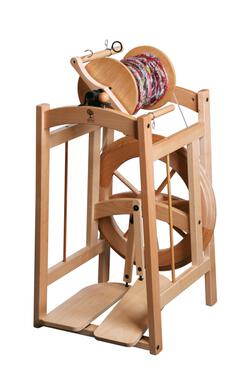 |
|
| Drive Wheel Diameter | 18” |
| Weight (lbs) | 14.5 lbs |
| ratios | 4 |
| bobbins (capacity) and accessories | 1 bobbins (2 1 / 5 lbs) Threading Hook How To Spin Booklet |
Kromski Spinning Wheels |
|
 |
Symphony |
| Drive Wheel Diameter | 24” |
| Weight (lbs) | 15 |
| Ratios | 7.5, 20 |
| # of included bobbins (capacity) and accessories | 3 bobbins (6 oz) Lazy Kate |
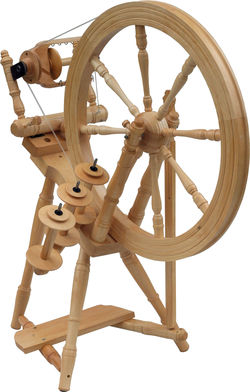 |
Interlude |
| Drive Wheel Diameter | 22” |
| Weight (lbs) | 11 |
| Ratios | 7, 13.5, 15.5 |
| # of included bobbins (capacity) and accessories | 3 bobbins (4 oz) Lazy Kate |
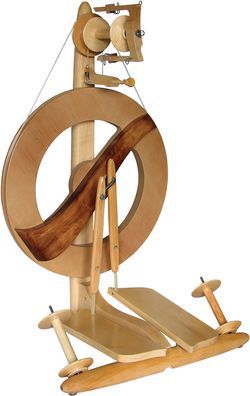 |
Fantasia |
| Drive Wheel Diameter | 18” |
| Weight (lbs) | 12.5 |
| Ratios | 5, 8 (10, 14, 18, 20) |
| # of included bobbins (capacity) and accessories | 3 bobbins (6 oz) Attached Lazy Kate elastic drive band |
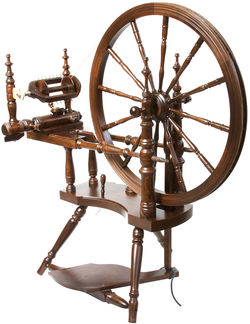 |
Polonaise |
| Drive Wheel Diameter | 24” |
| Weight (lbs) | 16 |
| Ratios | 8 – 20 |
| # of included bobbins (capacity) and accessories | 3 bobbins (6 oz) Vertical Lazy Kate |
 |
Minstrel |
| Drive Wheel Diameter | 18” |
| Weight (lbs) | 13 |
| Ratios | 6.5, 8.5, 12, 16 |
| # of included bobbins (capacity) and accessories | 3 bobbins (6 oz) Attached Lazy Kate 2 whorls |
 |
Sonata |
| Drive Wheel Diameter | 19” |
| Weight (lbs) | 11.5 |
| Ratios | 6.7, 12.5, 14 |
| # of included bobbins (capacity) and accessories | 3 bobbins (6 oz) Attached Lazy Kate Carrying Bagbobbins accessories |
Louet Spinning Wheels |
|
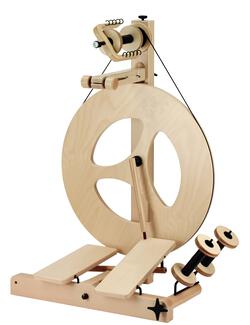 |
|
| Drive Wheel Diameter | 19.75” |
| Weight (lbs) | 13 |
| Ratios | 5.5, 7.5, 10.5 |
| bobbins (capacity) and accessories | 3 bobbins (6-8 oz) Attached Lazy Kate |
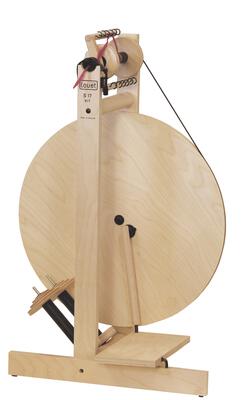 |
|
| Drive Wheel Diameter | 19.75” |
| Weight (lbs) | 11 |
| Ratios | 5.5, 7.5, 10.5 |
| bobbins (capacity) and accessories | 3 bobbins (6-8 oz) Attached Lazy Kate |
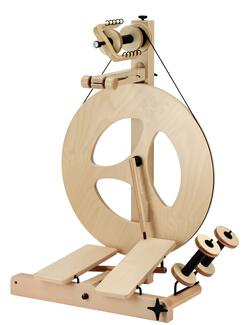 |
|
| Drive Wheel Diameter | 19.75” |
| Weight (lbs) | 11 |
| Ratios | 6, 8.5, 12.5, 19 |
| bobbins (capacity) and accessories | 3 bobbins (6-8 oz) Lazy Kate Sliding Hook |
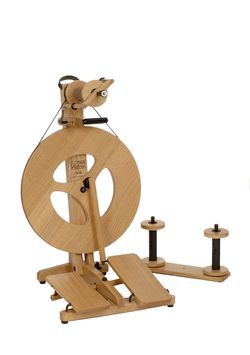 |
|
| Drive Wheel Diameter | 14.25” |
| Weight (lbs) | 8 |
| Ratios | 6, 8.5, 13 |
| bobbins (capacity) and accessories | 3 bobbins (6-8 oz) Lazy Kate Carrying Case |
Majacraft Spinning Wheels |
|
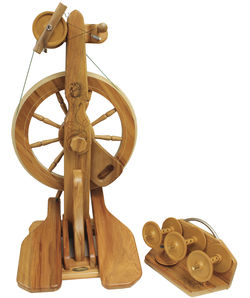 |
|
| Drive Wheel Diameter | 17.5” |
| Weight (lbs) | 13.2 |
| Ratios | 4.25, 6.5, 9, 12, 15* |
| Bobbins (capacity) and accessories | 4 bobbins (6 oz) Rose Carrier |
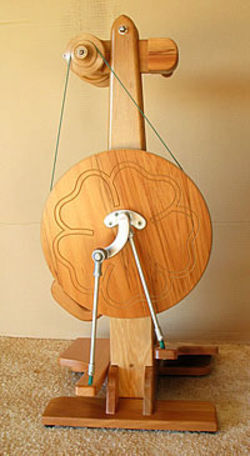 |
|
| Drive Wheel Diameter | 12.5” |
| Weight (lbs) | 14.5 |
| Ratios | 4.4, 6.9, 10, 13.1, 16* |
| Bobbins (capacity) and accessories | 4 bobbins (6 oz) |
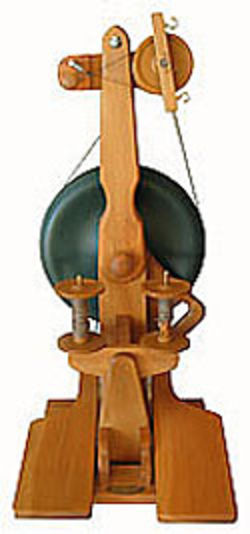 |
|
| Drive Wheel Diameter | 13” |
| Weight (lbs) | 14.3 |
| Ratios | 4.4, 6.9, 10, 13.1, 16* |
| Bobbins (capacity) and accessories | 4 bobbins (6 oz) |
 |
|
| Drive Wheel Diameter | 8.25” |
| Weight (lbs) | 10 |
| Ratios | 4.9, 5.9, 8.6, 10.8, 13.1* |
| Bobbins (capacity) and accessories | 3 bobbins (6 oz) Padded Bag 2 Bobbin Lazy Kate |
 |
|
| Drive Wheel Diameter | 12.75” |
| Weight (lbs) | 11 |
| Ratios | 4.7, 7.3, 10.3, 13.3, 16* |
| Bobbins (capacity) and accessories | 3 bobbins (6 oz) |
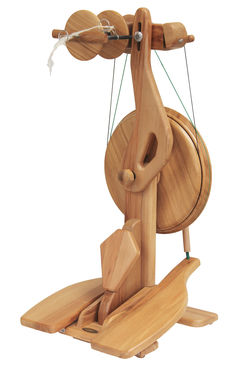 |
|
| Drive Wheel Diameter | 13.25” |
| Weight (lbs) | 16.5 |
| Ratios | 4.1, 5.4, 7.3 |
| Bobbins (capacity) and accessories | 3 bobbins (6 oz) |
Schacht Spinning Wheels |
|
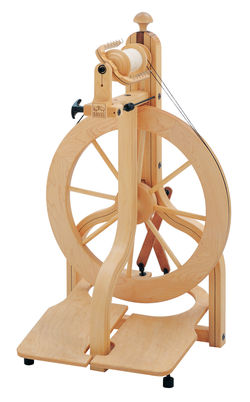 |
Matchless |
| Drive Wheel Diameter | 19.5 |
| Weight, lbs. | 16 / 17 |
| Ratios med & fast (w/ opt. whorls) | 9, 11, 13, 15.5 (4 – 22) |
| bobbins (capacity) and accessories | 4 bobbins (3. oz) Lazy Kate carrying strap |
 |
Reeves 24″ |
| Drive Wheel Diameter | 24 |
| Weight, lbs. | 20 |
| Ratios med & fast (w/ opt. whorls) | 12, 14.5, 16, 19 (8 – 31) |
| bobbins (capacity) and accessories | 4 bobbins (3. oz) Lazy Kate |
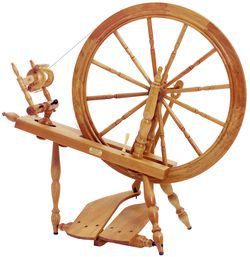 |
Reeves 30″ |
| Drive Wheel Diameter | 30 |
| Weight, lbs. | 28 |
| Ratios med & fast (w/ opt. whorls) | 14.5 18, 20, 24 (9.5 – 38.5) |
| bobbins (capacity) and accessories | 3 bobbins (3. oz) Lazy Kate |
| Model and Variations | Lady Bug |
| Drive Wheel Diameter | 16 |
| Weight, lbs. | 12.5 |
| Ratios med & fast (w/ opt. whorls) | 7, 9, 10.5, 12.5 (5 – 16) |
| bobbins (capacity) and accessories | 3 bobbins (3. oz) *opt. attached Lazy Kate |
| Model and Variations | Sidekick |
| Drive Wheel Diameter | 13.75 |
| Weight, lbs. | 13 |
| Ratios med & fast (w/ opt. whorls) | 6.25, 7.5, 9, 11 (4.25 – 13.75) |
| bobbins (capacity) and accessories | 3 bobbins (3. oz) |



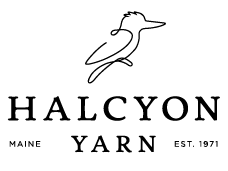
Do any wheels have an optional distaff for flax spinning? If not, where do I find a free-standing distaff?
Thanks for the question! Unfortunately, the distaff for flax spinning that we used to carry has been discontinued by the manufacturer. We do not currently have an alternate supplier. You may have luck finding one used? Wish I had better news – best of luck in your search!
Good Day . Spinning is a new craft for me. I would like to purchase a folding spinning wheel that will allow me to spin Wooster weight and bulky art yarn. What do you suggest?
Thank you for your time
Rosalie
Dear Rosalie,
Great to hear that you’re leaning to spin! A folding/portable wheel is a great choice since you can easily take it to a class or group and get extra support while you try out new skills.
The Ashford Joy 2 is a lightweight fold-up model available in either single or double treadle versions that come come pre-assembled so it’s ready to spin right out of the box. It will spin a good range of weights, however if you want to do extra bulky or textured yarns you may want to consider the Schacht Sidekick.
The Schacht Sidekick is a double-treadle fold-up wheel that offers an additional “Bulky Plyer Flyer” that can be swapped in to achieve heavier weights and plys. The Schacht is a little more expensive if you do get the additional flyer, however if that’s the weight that interests you most it may be a better long-term investment.
I hope that helps you make a selection, please feel free to call the shop too if we can provide additional info or help you with an order.
Happy Spinning!